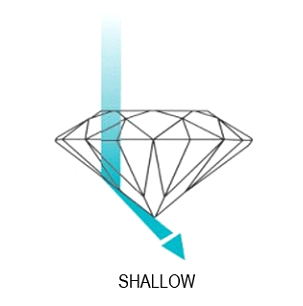A Diamond’s Cut Unleashes Its Light
The traditional 58 facets in a round brilliant diamond, each precisely cut and defined, are as small as two millimetres in diameter. But without this precision, a diamond wouldn’t be nearly as beautiful. The allure of a particular diamond depends more on cut than anything else.
Though extremely difficult to analyze or quantify, the cut of any diamond has three attributes: brilliance (the total light reflected from a diamond), fire (the dispersion of light into the colors of the spectrum), and scintillation (the flashes of light, or sparkle, when a diamond is moved).
An understanding of diamond cut begins with the shape of a diamond. The standard round brilliant is the shape used in most diamond Jewelry. All others are known as fancy shapes. Traditional fancy shapes include the marquise, pear, oval and emerald cuts. Hearts, cushions, triangles and a variety of others are also gaining popularity in diamond Jewelry
As a value factor, though, cut refers to a diamond’s proportions, symmetry and polish. For example, look at a side view of the standard round brilliant. The major components, from top to bottom, are the crown, girdle and pavilion. A round brilliant cut diamond has 57 or 58 facets, the 58th being a tiny flat facet at the bottom of the pavilion that’s known as the culet. The large, flat facet on the top is the table. The proportions of a diamond refer to the relationships between table size, crown angle and pavilion depth. A wide range of proportion combinations are possible, and these ultimately affect the stone’s interaction with light.
A diamonds’ Cut quality is divided in to the following grades:
Excellent, Very Good, Good, Fair and Poor.
To qualify as an Excellent Cut, there needs to be excellent proportions and excellent light performance. The result is a very bright diamond.
Generally there will be an even distribution of light all around the diamond and the diamond will also have excellent scintillation (sparkle effects) with both white light and dark light areas.
This diamond needs to fall into a certain range of percentages and angles to qualify as an excellent cut, and even then, if all the percentages do fall within these ranges, they could combine together and form a negative affect which can then lower the cut grade.

A Very Good Cut Grade has Great Qualities and maybe even some Excellent qualities. They contain great light performance and great proportions.
Not all proportions are perfect though, some Diamonds may have a thick Girdle or a Shallow Crown Angle. Overall, Very Good Cuts are beautiful Diamonds and one of the best Cuts you can get.
Anything Very Good or Excellent are the best Grades that money can buy.

Good Cut Grades are a nice average quality of Cut to have in a Diamond. They have good Sparkle and good Brilliance. These Diamonds have some great qualities but lack some of the Fire and Life that better Cut Diamonds are known for. Most people probably wouldn’t notice this difference unless you compared the Cuts side by side.
The Angles of the Crown and Pavilion can be Deep or Shallow and you may see more darkness in the stone. Overall, a Good Cut with Good Sparkle.

Diamonds with a Fair Cut are not the brightest bunch. You will see many dark shadows in the stone. The stone can be very steep, lumpy or quite shallow and thin. These cuts will bring the price of the diamond down.
“This diamond is $1000 cheaper than our competitors!!”
…And for a very good reason!

Poorly cut diamonds will not have much sparkle. The angles and proportions and symmetry will all be off.
The depth may be really deep and lumpy, or it could be very thin, dangerous, and vulnerable to chipping or breaking.
Culet Sizes can be thick and off center. Facets might be out of alignment. Tables can be skewed or lopsided. Crowns can be uneven. These diamonds lack life, luster and shine.
